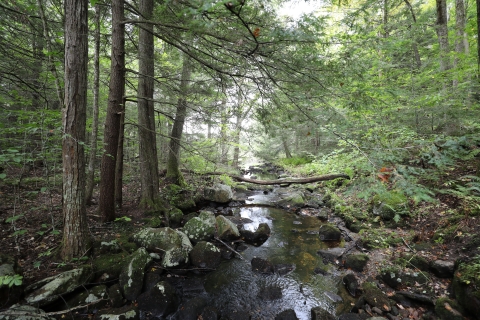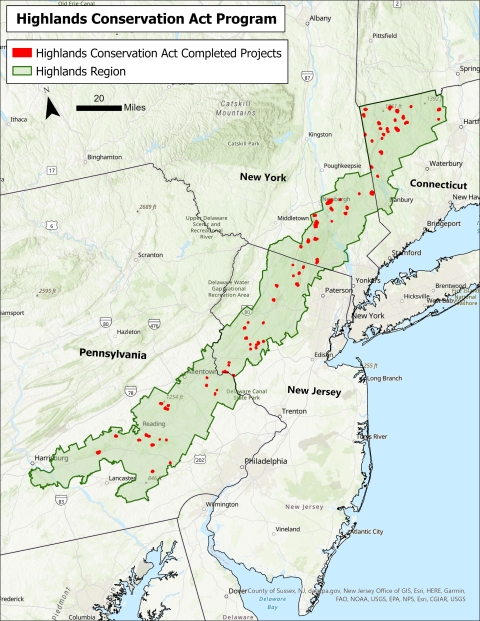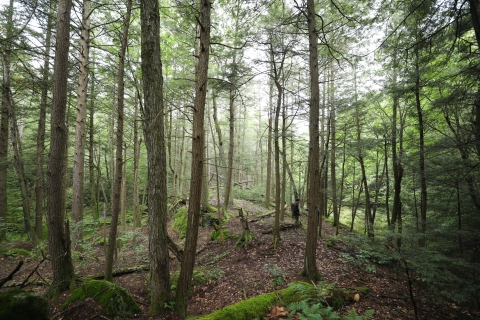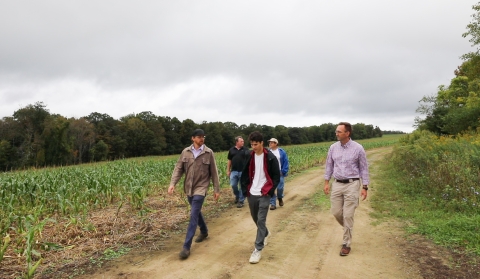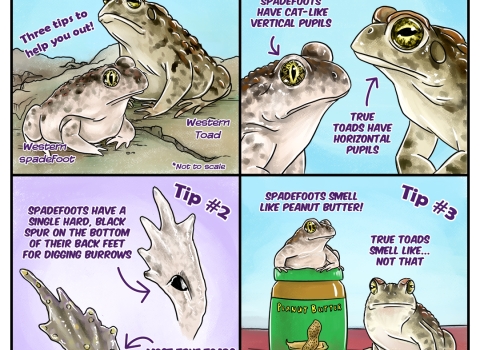When you set foot on Beech Hill in Goshen, Connecticut, you sense you’re someplace special. Birdsong wafts from the deep forest. A dirt road bisects a corn field and meanders into the distance, encouraging discovery. This is the welcoming sight a group of state, federal, municipal and nonprofit partners experienced last September during a tour of the site.
Bob Valentine, first selectman of the Town of Goshen, is one of those partners. Valentine grew up coming to Beech Hill. Standing next to a cold-water brook where he used to fish as a teenager, he shared, “This is an amazing piece of property. As you get down here, you can hear the birds and the wind, and very little civilization, which is a really great thing about this whole area.” That’s why Valentine and others are dedicated to conserving this place for future generations.
Conserving the 627-acre Beech Hill parcel was a top priority for the state as well. When it was listed on the open market in August 2019, Valentine notified Rick Jacobson, then chief of the Bureau of Natural Resources for the Connecticut Department of Energy and Environmental Protection. Jacobson is currently the assistant regional director for Fish and Aquatic Conservation in the Northeast Region.
“It’s the kind of property you just fall in love with the moment you step on it,” Jacobson said. “This is truly a rich and diverse ecological community, and this parcel is going to provide conservation opportunities for generations to come.”
Conserving the Highlands Region
A property of this size comes with a price tag to match. Securing reliable funding is one of the main challenges partners face when conserving land. That’s why Connecticut DEEP partnered with the Service’s Highlands Conservation Act grant program to acquire Beech Hill.
In 2004, the Highlands Conservation Act was signed into law to protect threatened and endangered species, safeguard clean drinking water, create outdoor recreational areas, and sustain working forests and farms in the Highlands Region. The Highlands Region is a 3.4-million-acre landscape of Appalachian ridges, hills, and plateaus that stretches from northwestern Connecticut, through New York and New Jersey, to eastern Pennsylvania.
Through the grant program, the Service awards funding for land conservation projects to state agencies, which raise matching funds from other partners. Over the past 17 years, the unique public and private partnership behind the Highlands Conservation Act Program has conserved 12,766 acres. In addition to the Service, partners include the four Highlands states, the nonprofit land conservation community, and the USDA Forest Service.
Tim Abbott, regional land conservation director for the Housatonic Valley Association, is a leader among the nonprofit land conservation organizations that provide critical support to the Highlands program.
“The Highlands Conservation Act is the most significant source of federal conservation dollars that come to Connecticut for this region,” Abbott said. “I would argue, outside of the Farm Bill, it’s the most significant source of conservation dollars for the entire four-state Highlands region, and it does tremendous work.”
“The fact that it leverages state funding, private funding, and municipal funding makes it a very helpful tool,” he explained. “Without a way to partner with local land trusts, much less significant conservation would be possible, and it would take a lot longer.”
Beech Hill was the perfect candidate for Highlands Conservation Act funding. It comprises 1.5 miles of cold-water streams, 50 acres of wetlands and ponds, and more than 500 acres of forest. It includes multiple habitat types identified as Greatest Conservation Need by Connecticut’s Wildlife Action Plan, the state’s road map for wildlife conservation.
Ecological and Recreational Importance of Beech Hill
The property abuts 100 acres of the Goshen Wildlife Management Area (WMA), with another 900 acres of Goshen WMA nearby, to the north. Conserving Beech Hill not only protects the unique habitats on the property, but also adds to a network of protected lands and waters in the state, and beyond.
“The Highlands program is really integral to everything we do as a Wildlife Division — it’s another way that we can help protect open space for a lot of the species that we work with,” Jenny Dickson, director of the Wildlife Division of Connecticut DEEP, explained. “It also helps us connect habitats to form migration corridors, so that wildlife have a greater opportunity to thrive and adjust to climate change climate change
Climate change includes both global warming driven by human-induced emissions of greenhouse gases and the resulting large-scale shifts in weather patterns. Though there have been previous periods of climatic change, since the mid-20th century humans have had an unprecedented impact on Earth's climate system and caused change on a global scale.
Learn more about climate change . Whether it’s something like a northern-long eared bat, which has become very rare in our state, or something big like a moose or a black bear, this is the type of program that can protect the special habitats they depend on.”
Along with these ecological benefits, the land will be available to the public for outdoor recreation. A number of activities, such as hunting, fishing, and bird watching, are already allowed on the land. Connecticut DEEP will determine if other types of outdoor recreation will be allowed through the development of a management plan for the property.
Pete Picone, wildlife biologist with Connecticut DEEP, who manages the property, explained: “First, we review what is biologically important and how to conserve those resources as much as possible. We may think about adding other [activities] depending on the resources that we have here.”
Public access is important to the Goshen community, which greatly supports open space. Their values align nicely with Connecticut DEEP, which ensures public access is part of every property with funding from the Highlands Conservation Act Program.
Celebrating the Property’s Preservation
The Beech Hill property was acquired on May 18, 2021. A celebration attended by a long list of partners and supporters, including U.S. Senator Chris Murphy, followed. The celebration signified a conservation success, but it also launched a new beginning for this property.
As Picone explained, “One of the challenges that we’re going to have in the next three years is to figure out how we’re going to convert these fields to biologically native and diverse vegetation. It’s going to be challenging, but we already have partners who want to fund some of this change, so it’s really exciting.”
Colleen Sculley, assistant regional director of the Service’s Wildlife and Sport Fish Restoration Program, which administers the Highlands program, is excited for what opportunities lie ahead. “I congratulate Connecticut DEEP and the partners who came together to conserve this property that supports listed and at-risk species and contributes to the conservation of the Highlands landscape in Connecticut, and we look forward to supporting many more conservation successes in the future.”
Abbott reflected on the impact the Highlands Conservation Act program has made on his career in land conservation. “It has been the essential part of a strategy of the land trust community here, working in partnership with the state,” he said. “We’ve been in it from the start, and as a result, we can dream bigger.”
Beech Hill showcases the great effort the partners put into each property protected under the Highlands Conservation Act. With Beech Hill acquired, the partners continue their search to find unique properties like it to protect for the future.
For more information on the Highlands Conservation Act, visit: https://fws.gov/program/highlands-conservation-act
Story by: Lauren Ramos, American Conservation Experience (ACE) Fellow, Assistant Grant Specialist


